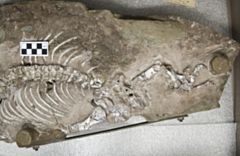Project 4352: R. B. Benson. 2012. Interrelationships of basal synapsids: cranial and postcranial morphological partitions suggest different topologies. Journal of Systematic Palaeontology. 10 (4):601-624.
Abstract
Basal synapsids (‘pelycosaurs’) form the basalmost portion of the mammalian stem lineage and document the transition from primitive ‘reptile-like’ basal amniotes to derived, mammal-like therapsids. They dominated terrestrial ecosystems of the latest Carboniferous and Early Permian (∼300–271 million years ago), producing large-bodied terrestrial animals (3–6.5 metres long), high-fibre herbivores, and macropredators for the first time in vertebrate history, alongside an array of smaller-bodied forms. Despite numerous recent discoveries and reassessments of fossils collected over the past 250 years, and despite their importance for understanding the early diversification of terrestrial vertebrates, a comprehensive assessment of global relationships among basal synapsids has not been undertaken. A new phylogenetic dataset comprising 45 taxa (plus four outgroups and four therapsids) and 239 characters (147 cranial; 92 postcranial) reveals considerable uncertainty in the relationships of higher clades of basal synapsids. Although cranial data support the current consensus that Caseasauria is the most basal clade, postcranial data and the full dataset suggest that a clade of Ophiacodontidae + Varanopidae occupies this position. Although relationships within higher clades are well supported, relationships among those clades are poorly supported. The likely source of this uncertainty lies in the exceptionally poor early record of the group, which renders determinations of the plesiomorphic condition of higher clades speculative, although cranial data are generally represented by shorter ghost lineages and should perhaps be favoured. The new dataset suggests well-supported phylogenetic placements for several taxa of historically uncertain affinities: Trichasaurus is a caseid; Lupeosaurus is an edaphosaurid; and Basicranodon and Ruthiromia are varanopids.Read the article »
Article DOI: 10.1080/14772019.2011.631042
Project DOI: 10.7934/P4352, http://dx.doi.org/10.7934/P4352
| This project contains |
|---|
Download Project SDD File |
Currently Viewing:
MorphoBank Project 4352
MorphoBank Project 4352
- Creation Date:
02 August 2022 - Publication Date:
02 August 2022 - Media downloads: 1

Authors' Institutions ![]()
- University of Cambridge

